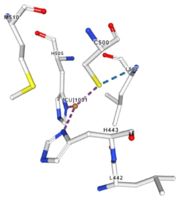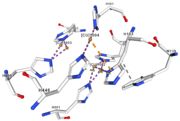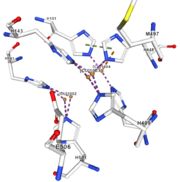Copper is one of the most important metallic cofactor involved in enzyme catalysed reactions. In living organisms, its function is related to its redox properties. However, copper is toxic at all concentration, therefore it needs to be strictly controlled by molecular mechanisms.[1]
Function
Multicopper oxidases are enzymes involved in copper homeostasis. Indeed, free copper present in a cell (so, not bounded to a protein) is harmful and can cause cellular damage. It needs to be regulated. So, multicopper oxydases CueO 4e9s is essential.
Multicopper oxidase acts probably for the detoxification of copper present in the periplasmic space. It oxidizes the Cu+ into Cu2+ and prevents its uptake by the cytoplasm. It also possesses a phenoloxidase and a ferroxidase activity which can be involved in the prevention of oxidative damage.[2]
Multicopper oxidase might also be involved in the regulation of metal transport.
Multicopper oxidases are able to oxidise their substrates thanks to their particular structure. They own four copper ions (Cu1001, Cu1002, Cu1003 and C1004) dispatched between two important areas : the mononuclear copper center (Cu1001) and the trinuclear copper center (Cu1002, Cu1003 and Cu1004).
Mechanism
Multicopper oxidase catalyzes the oxidation of different substrates by reducing O2 into H2O without releasing activated oxygen species (H2O2).
Three differents copper centers exist that can be differentiated spectroscopically: Type 1 or blue (), type 2 or normal and type 3 or coupled binuclear.[3][4].
Multicopper oxidase contains these 3 types of copper ions. They are all involved in the transfer of electrons from the substrate to the dioxygen. The first type of copper, type 1, (Cu1001) mediates the electron transfer from the substrate to the other coppers. The formed by the three other coppers is the key element for the oxygen reduction. It contains a type 2 copper (Cu1004) and two type 3 copper ions, binuclear ions, (Cu1002 and Cu1003). The final electron acceptor, O2, is bound to this last type of copper and is reduced into two molecules of water thanks to the transfer of four electrons allowed by the oxidation of the four copper ions.[5]
Disease
If the amino acids 500 and 501 are mutated from CH to SR, their is a loss of resistance to copper which is highly harmful for the bacteria.
Oxygen deprivation also leads to protein degradation.
Structural highlights
Multicopper Oxidase CueO 4e9s is a protein containing one chain with sequence from Ecoli. Full crystallographic information is available from OCA. For a guided tour on the structure components use FirstGlance.
|
| Ligands: | 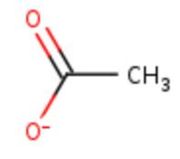 Figure 1: Acetate ion. [6] |
| Related: | 4e9p, 4e9q, 4e9r, 4e9t |
| Gene: | cueO, yacK, b0123, JW0119 (ECOLI) |
| Function: | binding of a metal ion |
| Process: | oxidation-reduction |
| Position: | bound at the outer membrane in the periplasmic space |
| Chain: | A |
| Sequence domain: | Cupredoxin, Multicopper oxidase type 1, type 2, type 3 and a copper-binding site |
| Number of amino acids: | 489 |
| Production and extraction: | Escherichia Coli |
| Initial gene: | sequence from amino acid 29 to amino acid 516 from P36649 |
| Specific region: | contain a methionine rich region (aa355 to aa400) that can be important for copper tolerance in bacteria |
| Resources: | FirstGlance, OCA, PDBe, RCSB, PDBsum, ProSAT, EMBL-EBI |
| In the chain, five ligands are present: an acetate ion (C2H3O2) and four copper ions.
Even if the trinuclear copper center is deeply buried inside the protein, the channel is dynamic enough to allow the acetate ion to approach. It has been noticed that adding acetate ion is enhancing the enzymatic activity of the protein.
|
| Cu1001: The copper ion is bound with H443, H505 and C500 thanks to three metallic interactions. The structure is stabilised by hydrogen bounds with L502, M510. |
| Cu1002: The binuclear copper ion is bound with three three histidines : H501, H103, and H141. Each bound is a double metallic interaction because the two nucleus of the binuclear ion are bound. The structure is stabilised by hydrophobic contact between H141 and W139 |
| Cu1003: The binuclear copper ion is bound with three with three histidines : H499, H143, and H448. Each bound is a double metallic interaction. The structure is stabilised by Pi interactions with Cu1004 and H101 |
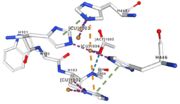 Figure 5: Copper 1004 [10] | Cu1004: The copper ion is bound by metallic interaction with two histidines : H101 and H446, and with Act1005. The structure is stabilised by Pi interactions between H446 and two other histidine : H103 and H448. Cu1004 bounds also by Pi interactions with H103 and H448. Moreover, their are Pi interactions between H113 and H446 |
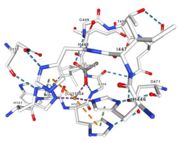 Figure 6: Acetate ion 1005 [11] | Act1005: The acetate ion is linked by hydrogen bonds to G104 and G449. |
Cu1002, Cu1003, Cu1004 and Act1005 are very closed in the space. The three copper ions form the trinuclear copper center. The bound lengths are nearly equal so the three copper are arranged as a triangle.
The amino acid sequence is:
|
| 29 | 30 | 31 | 32 | 33 | 34 | 35 | 36 | 37 | 38 | 39 | 40 | 41 | 42 | 43 | 44 | 45 | 46 | 47 | 48 | 49 | 50 | 51 | 52 | 53 | 54 | 55 | 56 | 57 | 58 |
| A | E | R | P | T | L | P | I | P | D | L | L | T | T | D | A | R | N | R | I | Q | L | T | I | G | A | G | Q | S | T |
| 59 | 60 | 61 | 62 | 63 | 64 | 65 | 66 | 67 | 68 | 69 | 70 | 71 | 72 | 73 | 74 | 75 | 76 | 77 | 78 | 79 | 80 | 81 | 82 | 83 | 84 | 85 | 86 | 87 | 88 |
| F | G | G | K | T | A | T | T | W | G | Y | N | G | N | L | L | G | P | A | V | K | L | Q | R | G | K | A | V | T | V |
| 89 | 90 | 91 | 92 | 93 | 94 | 95 | 96 | 97 | 98 | 99 | 100 | 101 | 102 | 103 | 104 | 105 | 106 | 107 | 108 | 109 | 110 | 111 | 112 | 113 | 114 | 115 | 116 | 117 | 118 |
| D | I | Y | N | Q | L | T | E | E | T | T | L | H | W | H | G | L | E | V | P | G | E | V | D | G | G | P | Q | G | I |
| 119 | 120 | 121 | 122 | 123 | 124 | 125 | 126 | 127 | 128 | 129 | 130 | 131 | 132 | 133 | 134 | 135 | 136 | 137 | 138 | 139 | 140 | 141 | 142 | 143 | 144 | 145 | 146 | 147 | 148 |
| I | P | P | G | G | K | R | S | V | T | L | N | V | D | Q | P | A | A | T | C | W | F | H | P | H | Q | H | G | K | T |
| 149 | 150 | 151 | 152 | 153 | 154 | 155 | 156 | 157 | 158 | 159 | 160 | 161 | 162 | 163 | 164 | 165 | 166 | 167 | 168 | 169 | 170 | 171 | 172 | 173 | 174 | 175 | 176 | 177 | 178 |
| G | R | Q | V | A | M | G | L | A | G | L | V | V | I | E | D | D | E | I | L | K | L | M | L | P | K | Q | W | G | I |
| 179 | 180 | 181 | 182 | 183 | 184 | 185 | 186 | 187 | 188 | 189 | 190 | 191 | 192 | 193 | 194 | 195 | 196 | 197 | 198 | 199 | 200 | 201 | 202 | 203 | 204 | 205 | 206 | 207 | 208 |
| D | D | V | P | V | I | V | Q | D | K | K | F | S | A | D | G | Q | I | D | Y | Q | L | D | V | M | T | A | A | V | G |
| 209 | 210 | 211 | 212 | 213 | 214 | 215 | 216 | 217 | 218 | 219 | 220 | 221 | 222 | 223 | 224 | 225 | 226 | 227 | 228 | 229 | 230 | 231 | 232 | 233 | 234 | 235 | 236 | 237 | 238 |
| W | F | G | D | T | L | L | T | N | G | A | I | Y | P | Q | H | A | A | P | R | G | W | L | R | L | R | L | L | N | G |
| 239 | 240 | 241 | 242 | 243 | 244 | 245 | 246 | 247 | 248 | 249 | 250 | 251 | 252 | 253 | 254 | 255 | 256 | 257 | 258 | 259 | 260 | 261 | 262 | 263 | 264 | 265 | 266 | 267 | 268 |
|
| C | N | A | R | S | L | N | F | A | T | S | D | N | R | P | L | Y | V | I | A | S | D | G | G | L | L | P | E | P | V |
| 269 | 270 | 271 | 272 | 273 | 274 | 275 | 276 | 277 | 278 | 279 | 280 | 281 | 282 | 283 | 284 | 285 | 286 | 287 | 288 | 289 | 290 | 291 | 292 | 293 | 294 | 295 | 296 | 297 | 298 |
| K | V | S | E | L | P | V | L | M | G | E | R | F | E | V | L | V | E | V | N | D | N | K | P | F | D | L | V | T | L |
| 299 | 300 | 301 | 302 | 303 | 304 | 305 | 306 | 307 | 308 | 309 | 310 | 311 | 312 | 313 | 314 | 315 | 316 | 317 | 318 | 319 | 310 | 321 | 322 | 323 | 324 | 325 | 326 | 327 | 328 |
| P | V | S | Q | M | G | M | A | I | A | P | F | D | K | P | H | P | V | M | R | I | Q | P | I | A | I | S | A | S | G |
| 329 | 330 | 331 | 332 | 333 | 334 | 335 | 336 | 337 | 338 | 339 | 340 | 341 | 342 | 343 | 344 | 345 | 346 | 347 | 348 | 349 | 350 | 351 | 352 | 353 | 354 | 355 | 356 | 357 | 358 |
| A | L | P | D | T | L | S | S | L | P | A | L | P | S | L | E | G | L | T | V | R | K | L | Q | L | S | M | D | P | M |
<tr<359 | 360 | 361 | 362 | 363 | 364 | 365 | 366 | 367 | 368 | 369 | 370 | 371 | 372 | 373 | 374 | 375 | 376 | 377 | 378 | 379 | 380 | 381 | 382 | 383 | 384 | 385 | 386 | 387 | 388 | </tr>
| L | D | M | M | G | M | Q | M | L | M | E | K | Y | G | D | Q | A | M | A | G | M | D | H | S | Q | M | M | G | H | M |
| 389 | 390 | 391 | 392 | 393 | 394 | 395 | 396 | 397 | 398 | 399 | 400 | 401 | 402 | 403 | 404 | 405 | 406 | 407 | 408 | 409 | 410 | 411 | 412 | 413 | 414 | 415 | 416 | 417 | 418 |
| G | H | G | N | M | N | H | M | N | H | G | G | K | F | D | F | H | H | A | N | K | I | N | G | Q | A | F | D | M | N |
| 419 | 420 | 421 | 422 | 423 | 424 | 425 | 426 | 427 | 428 | 429 | 430 | 431 | 432 | 433 | 434 | 445 | 436 | 437 | 438 | 439 | 440 | 441 | 442 | 443 | 444 | 445 | 446 | 447 | 448 |
| K | P | M | F | A | A | A | K | G | Q | Y | E | R | W | V | I | S | G | V | G | D | M | M | L | H | P | F | H | I | H |
| 449 | 450 | 451 | 452 | 453 | 454 | 455 | 456 | 457 | 458 | 459 | 460 | 461 | 462 | 463 | 464 | 465 | 466 | 467 | 468 | 469 | 470 | 471 | 472 | 473 | 474 | 475 | 476 | 477 | 478 |
| G | T | Q | F | R | I | L | S | E | N | G | K | P | P | A | A | H | R | A | G | W | K | D | T | V | K | V | E | G | N |
| 479 | 480 | 481 | 482 | 483 | 484 | 485 | 486 | 487 | 488 | 489 | 490 | 491 | 492 | 493 | 494 | 495 | 496 | 497 | 498 | 499 | 500 | 501 | 502 | 503 | 504 | 505 | 506 | 507 | 508 |
| V | S | E | V | L | V | K | F | N | H | D | A | P | K | E | H | A | Y | M | A | H | C | H | L | L | E | H | E | D | T |
| 509 | 510 | 511 | 512 | 513 | 514 | 515 | 516 |
| G | M | M | L | G | F | T | V |
Stabilisation of Cu1001
|
Stabilisation of Cu1002
|
Stabilisation of Cu1003
|
Stabilisation of Cu1004
|
Stabilisation of Act1005
|
[12]

